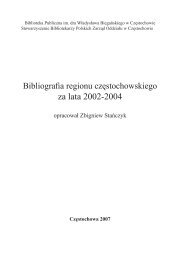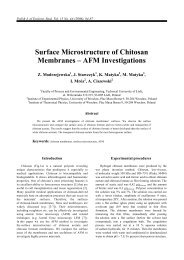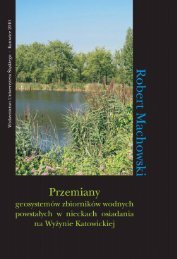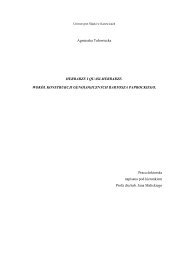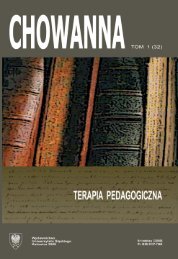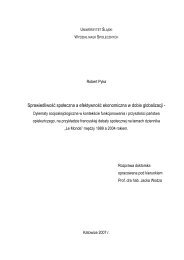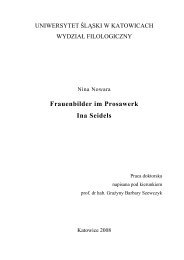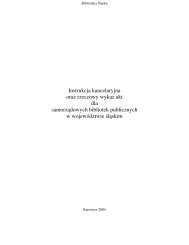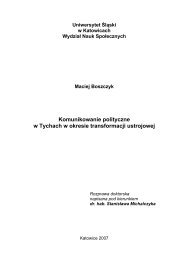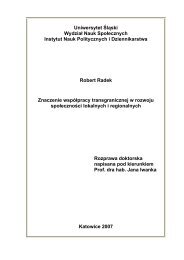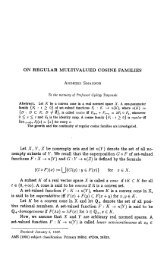- Page 3 and 4:
Przestrzeniewe wspó³czesnymteatrz
- Page 5 and 6:
Przestrzeniewe wspó³czesnymteatrz
- Page 7 and 8:
Spis treœciS³owo wstêpne (Ewa W
- Page 9:
Spis treœciDorota BuchwaldTeatr to
- Page 12 and 13:
10 S³owo wstêpnektóre charaktery
- Page 15:
Czêœæ pierwszaTradycjai wspó³c
- Page 18 and 19:
16 Czêœæ pierwsza: Tradycja i ws
- Page 20 and 21:
18 Czêœæ pierwsza: Tradycja i ws
- Page 22 and 23:
20 Czêœæ pierwsza: Tradycja i ws
- Page 24 and 25:
22 Czêœæ pierwsza: Tradycja i ws
- Page 26 and 27:
24 Czêœæ pierwsza: Tradycja i ws
- Page 28 and 29:
Ewa W¹chockaUniwersytet Œl¹skiKa
- Page 30 and 31:
28 Czêœæ pierwsza: Tradycja i ws
- Page 32 and 33:
30 Czêœæ pierwsza: Tradycja i ws
- Page 34 and 35:
32 Czêœæ pierwsza: Tradycja i ws
- Page 36 and 37:
34 Czêœæ pierwsza: Tradycja i ws
- Page 38 and 39:
36 Czêœæ pierwsza: Tradycja i ws
- Page 41 and 42:
Ewa W¹chocka: Przestrzenie wewnêt
- Page 43 and 44:
Ewa W¹chocka: Przestrzenie wewnêt
- Page 45 and 46:
Szymon DanowskiUniwersytet im. Adam
- Page 47 and 48:
Szymon Danowski: Przestrzeñ teatru
- Page 49 and 50:
Szymon Danowski: Przestrzeñ teatru
- Page 51 and 52:
Szymon Danowski: Przestrzeñ teatru
- Page 53 and 54:
Szymon Danowski: Przestrzeñ teatru
- Page 55 and 56:
Szymon Danowski: Przestrzeñ teatru
- Page 57 and 58: Eleonora UdalskaUniwersytet Œl¹sk
- Page 59 and 60: Eleonora Udalska: Plany przestrzeni
- Page 61 and 62: Eleonora Udalska: Plany przestrzeni
- Page 63 and 64: Eleonora Udalska: Plany przestrzeni
- Page 65 and 66: Eleonora Udalska: Plany przestrzeni
- Page 67 and 68: Eleonora Udalska: Plany przestrzeni
- Page 69 and 70: Eleonora Udalska: Plany przestrzeni
- Page 71 and 72: Dorota Fox: Gra przestrzeni¹ w szt
- Page 73 and 74: Dorota Fox: Gra przestrzeni¹ w szt
- Page 75 and 76: Dorota Fox: Gra przestrzeni¹ w szt
- Page 77 and 78: Dorota Fox: Gra przestrzeni¹ w szt
- Page 79 and 80: Dorota Fox: Gra przestrzeni¹ w szt
- Page 81 and 82: Dorota Fox: Gra przestrzeni¹ w szt
- Page 83 and 84: Joanna Michalczuk: Karpowiczowskie
- Page 85 and 86: Joanna Michalczuk: Karpowiczowskie
- Page 87 and 88: Joanna Michalczuk: Karpowiczowskie
- Page 89 and 90: Joanna Michalczuk: Karpowiczowskie
- Page 91 and 92: Joanna Michalczuk: Karpowiczowskie
- Page 93 and 94: Joanna Michalczuk: Karpowiczowskie
- Page 95 and 96: Joanna Michalczuk: Karpowiczowskie
- Page 97 and 98: Irena GórskaUniwersytet im. Adama
- Page 99 and 100: Irena Górska: Przestrzenie teatru
- Page 101 and 102: Irena Górska: Przestrzenie teatru
- Page 103 and 104: Irena Górska: Przestrzenie teatru
- Page 105 and 106: Irena Górska: Przestrzenie teatru
- Page 107: Irena Górska: Przestrzenie teatru
- Page 111 and 112: Beata Popczyk-Szczêsna: Zamkniêci
- Page 113 and 114: Beata Popczyk-Szczêsna: Zamkniêci
- Page 115 and 116: Beata Popczyk-Szczêsna: Zamkniêci
- Page 117 and 118: Beata Popczyk-Szczêsna: Zamkniêci
- Page 119 and 120: Beata Popczyk-Szczêsna: Zamkniêci
- Page 121 and 122: Beata Popczyk-Szczêsna: Zamkniêci
- Page 123: Czêœæ drugaPrzestrzeñdramatyczn
- Page 126 and 127: 124 Czêœæ druga: Przestrzeñ dra
- Page 128 and 129: 126 Czêœæ druga: Przestrzeñ dra
- Page 130 and 131: 128 Czêœæ druga: Przestrzeñ dra
- Page 132 and 133: 130 Czêœæ druga: Przestrzeñ dra
- Page 134 and 135: 132 Czêœæ druga: Przestrzeñ dra
- Page 136 and 137: 134 Czêœæ druga: Przestrzeñ dra
- Page 138 and 139: 136 Czêœæ druga: Przestrzeñ dra
- Page 140 and 141: 138 Czêœæ druga: Przestrzeñ dra
- Page 142 and 143: 140 Czêœæ druga: Przestrzeñ dra
- Page 144 and 145: 142 Czêœæ druga: Przestrzeñ dra
- Page 146 and 147: 144 Czêœæ druga: Przestrzeñ dra
- Page 148 and 149: 146 Czêœæ druga: Przestrzeñ dra
- Page 150 and 151: 148 Czêœæ druga: Przestrzeñ dra
- Page 152 and 153: 150 Czêœæ druga: Przestrzeñ dra
- Page 154 and 155: Dorota Jarz¹bekUniwersytet Jagiell
- Page 156 and 157: 154 Czêœæ druga: Przestrzeñ dra
- Page 158 and 159:
156 Czêœæ druga: Przestrzeñ dra
- Page 160 and 161:
158 Czêœæ druga: Przestrzeñ dra
- Page 162 and 163:
160 Czêœæ druga: Przestrzeñ dra
- Page 164 and 165:
162 Czêœæ druga: Przestrzeñ dra
- Page 166 and 167:
Dominika £arionowUniwersytet £ód
- Page 168 and 169:
166 Czêœæ druga: Przestrzeñ dra
- Page 170 and 171:
168 Czêœæ druga: Przestrzeñ dra
- Page 172 and 173:
170 Czêœæ druga: Przestrzeñ dra
- Page 174 and 175:
172 Czêœæ druga: Przestrzeñ dra
- Page 176 and 177:
174 Czêœæ druga: Przestrzeñ dra
- Page 178 and 179:
176 Czêœæ druga: Przestrzeñ dra
- Page 180 and 181:
178 Czêœæ druga: Przestrzeñ dra
- Page 182 and 183:
180 Czêœæ druga: Przestrzeñ dra
- Page 184 and 185:
182 Czêœæ druga: Przestrzeñ dra
- Page 186 and 187:
184 Czêœæ druga: Przestrzeñ dra
- Page 188 and 189:
186 Czêœæ druga: Przestrzeñ dra
- Page 190 and 191:
188 Czêœæ druga: Przestrzeñ dra
- Page 192 and 193:
190 Czêœæ druga: Przestrzeñ dra
- Page 194 and 195:
192 Czêœæ druga: Przestrzeñ dra
- Page 196 and 197:
194 Czêœæ druga: Przestrzeñ dra
- Page 198 and 199:
196 Czêœæ druga: Przestrzeñ dra
- Page 200 and 201:
198 Czêœæ druga: Przestrzeñ dra
- Page 202 and 203:
200 Czêœæ druga: Przestrzeñ dra
- Page 204 and 205:
202 Czêœæ druga: Przestrzeñ dra
- Page 206 and 207:
204 Czêœæ druga: Przestrzeñ dra
- Page 208 and 209:
206 Czêœæ druga: Przestrzeñ dra
- Page 210 and 211:
208 Czêœæ druga: Przestrzeñ dra
- Page 212 and 213:
210 Czêœæ druga: Przestrzeñ dra
- Page 214 and 215:
212 Czêœæ druga: Przestrzeñ dra
- Page 216 and 217:
214 Czêœæ druga: Przestrzeñ dra
- Page 218 and 219:
Jerzy LimonUniwersytet GdañskiGda
- Page 220 and 221:
218 Czêœæ druga: Przestrzeñ dra
- Page 222 and 223:
220 Czêœæ druga: Przestrzeñ dra
- Page 224 and 225:
222 Czêœæ druga: Przestrzeñ dra
- Page 226 and 227:
224 Czêœæ druga: Przestrzeñ dra
- Page 228 and 229:
226 Czêœæ druga: Przestrzeñ dra
- Page 230 and 231:
228 Czêœæ druga: Przestrzeñ dra
- Page 232 and 233:
230 Czêœæ druga: Przestrzeñ dra
- Page 234 and 235:
232 Czêœæ druga: Przestrzeñ dra
- Page 236 and 237:
234 Czêœæ druga: Przestrzeñ dra
- Page 238 and 239:
236 Czêœæ druga: Przestrzeñ dra
- Page 240 and 241:
238 Czêœæ druga: Przestrzeñ dra
- Page 242 and 243:
240 Czêœæ druga: Przestrzeñ dra
- Page 244 and 245:
Agnieszka Turek-NiewiadomskaInstytu
- Page 246 and 247:
244 Czêœæ druga: Przestrzeñ dra
- Page 248 and 249:
246 Czêœæ druga: Przestrzeñ dra
- Page 250 and 251:
248 Czêœæ druga: Przestrzeñ dra
- Page 252 and 253:
250 Czêœæ druga: Przestrzeñ dra
- Page 254 and 255:
252 Czêœæ druga: Przestrzeñ dra
- Page 256 and 257:
Miros³awa Koz³owskaUniwersytet Sz
- Page 258 and 259:
256 Czêœæ druga: Przestrzeñ dra
- Page 260 and 261:
258 Czêœæ druga: Przestrzeñ dra
- Page 262 and 263:
260 Czêœæ druga: Przestrzeñ dra
- Page 264 and 265:
262 Czêœæ druga: Przestrzeñ dra
- Page 266 and 267:
264 Czêœæ druga: Przestrzeñ dra
- Page 268 and 269:
266 Czêœæ druga: Przestrzeñ dra
- Page 270 and 271:
268 Czêœæ druga: Przestrzeñ dra
- Page 273:
Czêœæ trzeciaWieloœæ przestrze
- Page 276 and 277:
274 Czêœæ trzecia: Wieloœæ prz
- Page 278 and 279:
276 Czêœæ trzecia: Wieloœæ prz
- Page 280 and 281:
278 Czêœæ trzecia: Wieloœæ prz
- Page 282 and 283:
280 Czêœæ trzecia: Wieloœæ prz
- Page 284 and 285:
282 Czêœæ trzecia: Wieloœæ prz
- Page 286 and 287:
284 Czêœæ trzecia: Wieloœæ prz
- Page 288 and 289:
286 Czêœæ trzecia: Wieloœæ prz
- Page 290 and 291:
288 Czêœæ trzecia: Wieloœæ prz
- Page 292 and 293:
290 Czêœæ trzecia: Wieloœæ prz
- Page 294 and 295:
292 Czêœæ trzecia: Wieloœæ prz
- Page 296 and 297:
294 Czêœæ trzecia: Wieloœæ prz
- Page 298 and 299:
296 Czêœæ trzecia: Wieloœæ prz
- Page 300 and 301:
298 Czêœæ trzecia: Wieloœæ prz
- Page 302 and 303:
300 Czêœæ trzecia: Wieloœæ prz
- Page 304 and 305:
302 Czêœæ trzecia: Wieloœæ prz
- Page 306 and 307:
304 Czêœæ trzecia: Wieloœæ prz
- Page 308 and 309:
306 Czêœæ trzecia: Wieloœæ prz
- Page 310 and 311:
308 Czêœæ trzecia: Wieloœæ prz
- Page 312 and 313:
Ewa D¹bek-DerdaUniwersytet Œl¹sk
- Page 314 and 315:
312 Czêœæ trzecia: Wieloœæ prz
- Page 316 and 317:
314 Czêœæ trzecia: Wieloœæ prz
- Page 318 and 319:
316 Czêœæ trzecia: Wieloœæ prz
- Page 320 and 321:
318 Czêœæ trzecia: Wieloœæ prz
- Page 322 and 323:
320 Czêœæ trzecia: Wieloœæ prz
- Page 324 and 325:
322 Czêœæ trzecia: Wieloœæ prz
- Page 326 and 327:
324 Czêœæ trzecia: Wieloœæ prz
- Page 328 and 329:
326 Czêœæ trzecia: Wieloœæ prz
- Page 330 and 331:
328 Czêœæ trzecia: Wieloœæ prz
- Page 332 and 333:
330 Czêœæ trzecia: Wieloœæ prz
- Page 334 and 335:
332 Czêœæ trzecia: Wieloœæ prz
- Page 336 and 337:
334 Czêœæ trzecia: Wieloœæ prz
- Page 338 and 339:
336 Czêœæ trzecia: Wieloœæ prz
- Page 340 and 341:
338 Czêœæ trzecia: Wieloœæ prz
- Page 342 and 343:
340 Czêœæ trzecia: Wieloœæ prz
- Page 344 and 345:
342 Czêœæ trzecia: Wieloœæ prz
- Page 346 and 347:
344 Czêœæ trzecia: Wieloœæ prz
- Page 348 and 349:
346 Czêœæ trzecia: Wieloœæ prz
- Page 350 and 351:
348 Czêœæ trzecia: Wieloœæ prz
- Page 352 and 353:
350 Czêœæ trzecia: Wieloœæ prz
- Page 354 and 355:
352 Czêœæ trzecia: Wieloœæ prz
- Page 356 and 357:
354 Czêœæ trzecia: Wieloœæ prz
- Page 358 and 359:
356 Czêœæ trzecia: Wieloœæ prz
- Page 360 and 361:
358 Czêœæ trzecia: Wieloœæ prz
- Page 362 and 363:
360 Czêœæ trzecia: Wieloœæ prz
- Page 364 and 365:
362 Czêœæ trzecia: Wieloœæ prz
- Page 366 and 367:
364 Czêœæ trzecia: Wieloœæ prz
- Page 368 and 369:
366 Czêœæ trzecia: Wieloœæ prz
- Page 370 and 371:
368 Czêœæ trzecia: Wieloœæ prz
- Page 372 and 373:
370 Czêœæ trzecia: Wieloœæ prz
- Page 374 and 375:
372 Czêœæ trzecia: Wieloœæ prz
- Page 376 and 377:
374 Czêœæ trzecia: Wieloœæ prz
- Page 378 and 379:
376 Czêœæ trzecia: Wieloœæ prz
- Page 380 and 381:
Jan CiechowiczUniwersytet GdañskiG
- Page 382 and 383:
380 Czêœæ trzecia: Wieloœæ prz
- Page 384 and 385:
382 Czêœæ trzecia: Wieloœæ prz
- Page 386 and 387:
384 Czêœæ trzecia: Wieloœæ prz
- Page 388 and 389:
386 Czêœæ trzecia: Wieloœæ prz
- Page 390 and 391:
388 Czêœæ trzecia: Wieloœæ prz
- Page 392 and 393:
390 Czêœæ trzecia: Wieloœæ prz
- Page 394 and 395:
392 Czêœæ trzecia: Wieloœæ prz
- Page 396 and 397:
394 Czêœæ trzecia: Wieloœæ prz
- Page 398 and 399:
396 Czêœæ trzecia: Wieloœæ prz
- Page 400 and 401:
398 Czêœæ trzecia: Wieloœæ prz
- Page 402 and 403:
400 Czêœæ trzecia: Wieloœæ prz
- Page 404 and 405:
Gra¿yna NiewiadomskaCentrum Scenog
- Page 406 and 407:
404 Czêœæ trzecia: Wieloœæ prz
- Page 408 and 409:
406 Czêœæ trzecia: Wieloœæ prz
- Page 410 and 411:
408 Czêœæ trzecia: Wieloœæ prz
- Page 413 and 414:
Indeks osobowyAbbott Anthony S. 34A
- Page 415 and 416:
Indeks osobowy413Chmielowski Adam H
- Page 417 and 418:
Indeks osobowy415Helman Alicja 356H
- Page 419 and 420:
Indeks osobowy417Lorenc Iwona 351Lo
- Page 421 and 422:
Indeks osobowy419Platon 19, 298Ple
- Page 423 and 424:
Indeks osobowy421Szymanowski Piotr
- Page 426:
Na do³¹czonej do ksi¹¿ki p³yci




